The composition and diversity of natural regeneration of tree species in gaps under different intensities of forest disturbance
Maame Esi Hammond ·Radek Pokorný ·Daniel Okae-Anti ·Augustine Gyedu ·Irene Otwuwa Obeng
Abstract The positive ecological interaction between gap formation and natural regeneration has been examined but little research has been carried out on the effects of gaps on natural regeneration in forests under different intensities of disturbance.This study evaluates the composition,diversity,regeneration density and abundance of natural regeneration of tree species in gaps in undisturbed,intermittently disturbed,and disturbed forest sites.Bia Tano Forest Reserve in Ghana was the study area and three gaps each were selected in the three forest site categories.Ten circular subsampling areas of 1 m2 were delineated at 2 m spacing along north,south,east,and west transects within individual gaps.Data on natural regeneration <350 cm height were gathered.The results show that the intensity of disturbance was disproportional to gap size.Species diversity differed significantly between undisturbed and disturbed sites and,also between intermittently disturbed and disturbed sites for Simpson’s(1-D),Equitability (J),and Berger—Parker (B—P) indices.However,there was no significant difference among forest sites for Shannon diversity (H) and Margalef richness(MI) indices.Tree species composition on the sites differed.Regeneration density on the disturbed site was significantly higher than on the two other sites.Greater abundance and density of shade-dependent species on all sites identified them as opportunistic replacements of gap-dependent pioneers.Pioneer species giving way to shade tolerant species is a natural process,thus make them worst variant in gap regeneration.
Keywords Disturbed·Intermittently disturbed ·Undisturbed·Forest sites·Gap regeneration
Introduction
Forests are essential natural habitats for the conservation of biological diversity and the provision of numerous ecological functions and services.Natural regeneration promotes the sustainability of natural forest ecology as it involves the silvicultural practice of ‘close-to-nature’ forestry (Kuuluvainen and Laiho 2004).Natural regeneration facilitates the establishment and growth of native species (Danková and Saniga 2013) and hence enhances stability,resilience and diversity of forest ecosystems (Liira et al.2011).It is influenced by disturbances because patterns of regeneration rely greatly on interactions between disturbance regimes (i.e.,intensity,frequency,and scale) (de Carvalho et al.2017).High intensity of anthropogenic disturbances adversely affects species abundance,diversity (Bongers et al.2009),and regeneration in general.
Unfortunately,many tropical forests are continually under threat from various anthropogenic disturbances (Fischer et al.2016).Agricultural encroachment,logging (including permissible and illegal),and harvesting of non-timber forest products (NTFPs) for firewood,food,and medicinal purposes are the main types of this kind of forest disturbance(Eilu and Obua 2005;Lawer et al.2013).Nevertheless,disturbance from logging initiates the forest growth cycle through gap creation (Schliemann and Bockheim 2011;Toledo et al.2011).Essentially,this def nies and ecologically organizes forest species composition,structure,and process(Kooch et al.2010).Through the creation of gaps,conducive light-exposed growing environments encourage the proliferation and coexistence of different species,thus improving overall species diversity in the forest (Hammond et al.2020).In forest succession undergoing gap creation,the composition of natural regeneration may often differ from gaps of different sizes,shapes,orientations,and aspects due to the varying responses of species to disturbance and to light demands alongside the vegetation of the original stand and forest structure (de Carvalho et al.2017;Hammond et al.2020).Therefore,understanding species composition is a vital instrument in evaluating the sustainability of forests,species diversity and conservation,and the management of forest ecosystems (Kacholi 2014).In the long-term,knowledge of species composition,richness and the ecological characteristics of vegetation depends on biodiversity conservation (Ifo et al.2016).
In spite of the importance of natural regeneration for the preservation of genetic resources,its development and progress are often gradual due to the unassisted intricate interaction between seedling establishment and prevailing site conditions (Pardos et al.2005).Nevertheless,gaps are openings that provide resources to initiate vegetation succession processes which facilitate the rapid development of regeneration of different species (Hammond et al.2020).At the same time,gaps play a significant role in maintaining diversity in species-rich tropical forests (Hubbell et al.1999).Although several studies indicate positive ecological interaction between gap formation and natural regeneration(e.g.,Schliemann and Bockheim 2011;Danková and Saniga 2013;Lawer et al.2013;de Carvalho et al.2017;Hammond et al.2020),little research in Ghana has examined the effects of gaps formed by different disturbance levels on the composition and diversity of natural regeneration.Therefore,the aims of this study are:(1) to examine variations among gap sizes formed on undisturbed,intermittently disturbed and disturbed forest sites;(2) to compare species composition,diversity,and richness of natural regeneration in gaps at the three sites;and,(3) to examine the effects of different disturbances on regeneration density and abundance.
Materials and methods
Study area
The Bia Tano Forest Reserve (Fig.1) lies within the High Forest Zone of southern Ghana between latitudes 6° 52′—7°05′ N and longitudes 2° 30′— 2° 42′ W with an area of 18,197 ha.The reserve is a Tropical Moist Semi-Deciduous Northwest forest type (Hall and Swaine 1981),located at 213—274 m a.s.l with a prevailing tropical humid climate with annual mean rainfall and temperature of 1500 mm and 27.5 °C,respectively.The reserve is dominated by metamorphosed sediments of lower Birimian age schist and phyllite formation and drained by the Bia and Tano rivers from which it derives its name.The study area forms part of an ecological zone with an outstanding national biodiversity repository,recognized globally as a High Conservation Value (HCV) area,a def inition adopted by the Forest Stewardship Council (FSC) (MLNR 2016).The reserve has a rich mixture of tree species of uneven age due to different harvesting schedules following forest management guidelines,Minimum Felling Diameter (MFD) limits (50—110 cm) for different species.The study area is also a habitat for over 190 plant species,representing a magnificent diversity of trees,shrubs,herbs,lianas,and other life forms.Ecologically,numerous tree species often find their optimal abundance in this particular forest type.Hence,the Bia Tano Forest Reserve is classified under Category IV (habitat/species management area) of the International Union for Conservation of Nature protected area categories (MLNR 2016).Nevertheless,illegal logging,agricultural encroachment,and illegal harvesting of NTFPs due to the depletion of off -reserve lands and rapid annual growth of the surrounding communities pose major threats to the floristic biodiversity of the reserve.Tree heights vary from 20 m to a little above 50 m,diameters at breast height (dbh) vary from 30 cm to more than 65 cm (own data).
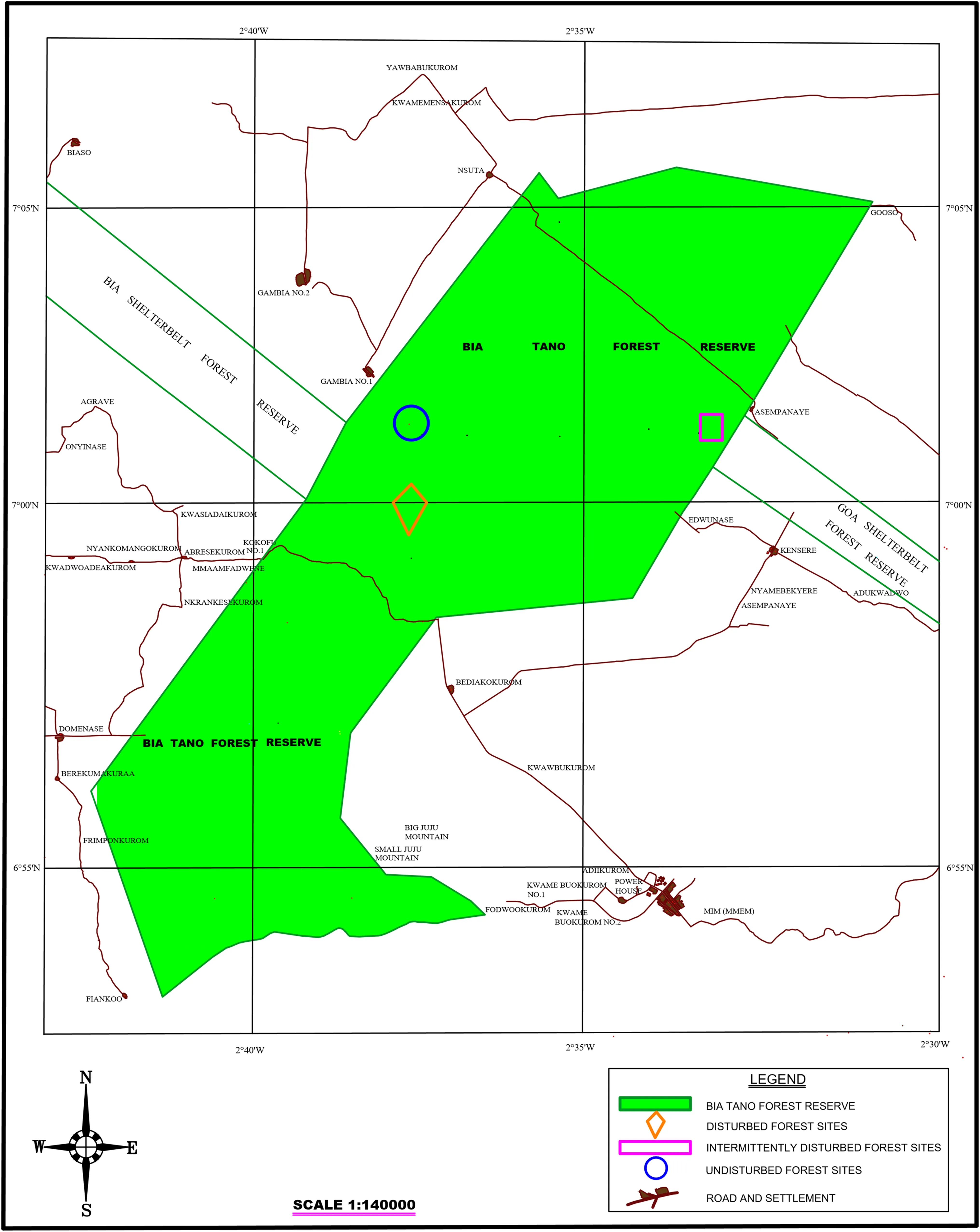
Fig.1 Map of Bia Tano Forest Reserve showing the three forest sites
Forest site stratification,gap size estimation and gap plot design
The study area (Fig.1) was stratif eid into three sites,namely:disturbed,intermittently disturbed and undisturbed,according to the intensity and frequency of disturbances (i.e.,mainly logging and harvesting of NTFPs).The disturbed site is an area under regular disturbance where gaps are formed from logging.The intermittently disturbed site is under irregular disturbances where gaps are formed from naturally-induced treefalls (trees that die while standing,snap off,uprooted) or occasionally from logging or the combination of both.The undisturbed site is an area where exploitation of tree resources is prohibited and its management is under strict surveillance.In this site,treefalls that create gaps usually come from snags or standing dead trees caused by insects,disease or climate.Mortality from stem breaking is relatively common on the undisturbed site due to overly mature trees in stands.In addition,the undisturbed site was used as a control for comparison.Within each site,three gap plots of relatively comparable size (± 244 m2) were selected (Table 1).A portable global positioning system(GPS) handset (Garmin Technologies,Inc;GPSMAP 66st model) was used to source geographical coordinates from eight different bordering spots around each gap plot according to the gap size estimate method of Babweteera et al.(2000).The coordinates of the nine gaps were subjected to AutoCAD software (version 2019) for their estimated sizes.Within each gap plot,four 20-m transects were set out in the four cardinal directions from the gap center and labeled as subplots (S).Along each subplot,ten circulars 1 m2(56 cm radius) subsample plots were demarcated at 2-m intervals and labeled.Prior to this layout,one subsampling plot was created at the gap center.Overall,the data sampling design consisted of 41 subsampling plots within a given gap plot,further giving 123 subsampling plots in each designated site.

Table 1 Soil surface conditions of gaps under different intensities of forest disturbance
Regeneration survey
Within each gap plot,all natural regeneration within the conf ines of the subsampling area of the gap center and along subplots were identified at a species level with assistance from a botany scientist,a local botanist,and experienced Forest Guards and Forestry Range Supervisors in addition to ‘Woody Plants of Western African Forests:A guide to the forest trees,shrubs,and lanes from Senegal to Ghana’(Hawthorne and Jongkind 2006) and a ‘Photo guide for the Forest Trees of Ghana’ (Hawthorne and Gyakari 2006).Tree species with dbh >10 cm or height >350 cm,or with both qualities were not considered as valid regeneration.
Natural regeneration was further grouped into three categories depending on their shade tolerance according to Hawthorne (1995).Pioneer species (Pi) require light for growth,shade tolerant (SH) are species that tolerate shade,while non-pioneer,light demanding (NPLD) are species with intermediate light-shade demands for growth.
Diversity indices estimation and data analysis
Paleontological statistics and educational software,version 3.24 (Hammer et al.2001) was used to estimate biodiversity indices.Six indices (Eq.1— 6) were relevant to the study objectives.
A general linear multivariate analysis was performed using TIBCO STATISTICA software (version 13.4.0.14) followed by a post hoc Fisher’s LSD test to compare significant differences in various indices between sites (n=3 per site) atp≤0.05.Descriptive statistics,frequencies and percentages,were performed with the same statistical software.
Simpson’s index (1-D) evaluated species dominance(Harper 1999):

Shannon diversity index (H) evaluated species diversity(Harper 1999).

Equitability,also known as Pielou’s Evenness (J),was used to evaluate species evenness(Harper 1999).

Margalef index (MI) evaluated species richness(Harper 1999).

Berger-Parker Index (B-P) was used to evaluate the numerical importance of the most abundant species (Berger and Parker 1970).

Lastly,Sorensen’s Similarity index (SSI) evaluated species similarity (Raup and Crick 1 979).

whereSis the total number of taxa,nis the total number of encountered individuals,niis the number of encountered individuals of taxoni,In is logarithm sign,Mis the number of mutually-shared similar species of the comparing duo,Nis the total number of species frequencies at forest sites in a column with presence in just one row of species frequency,andNmax is the total number of individuals of the most abundant tree species.
Results
Evaluation of gap size
There were significant (p<0.05) differences among estimated average gap sizes for the undisturbed site (1248 ± 2 m2),the intermittently disturbed site(1503 ± 81 m2) and the disturbed site (897 ± 39 m2)(Table 1).
Evaluation of regeneration composition,diversity and similarity
A total of 542 plants of 57 species from 23 families and 49 genera were identified (Table 2).The total regeneration density of the disturbed site (2753 trees/ha) was higher than the undisturbed site (1081 trees/ha) and the intermittently disturbed site (1065 trees/ha).The Malvaceae family (13 species) and Fabaceae family (nine species) were the most abundant families while 14 other families,for example,Anacardiaceae,Bignoniaceae,Clusiaceae,Lecythidaceae,Santalaceae were each represented by one species (Table 2).Non-pioneer,light-demanding species were the most common with 23 species,followed by pioneer species with 21,while shade tolerant species totaled 13.Non-pioneer,lighting-demanding species includedBlighia sapida,Mansonia altissimaandTrilepisium madagascariense,one pioneer species,Daniella ogeaand shade tolerant speciesBaphia nitida,Celtis mildbraediiandNesogordonia papaveriferawere common on all sites.
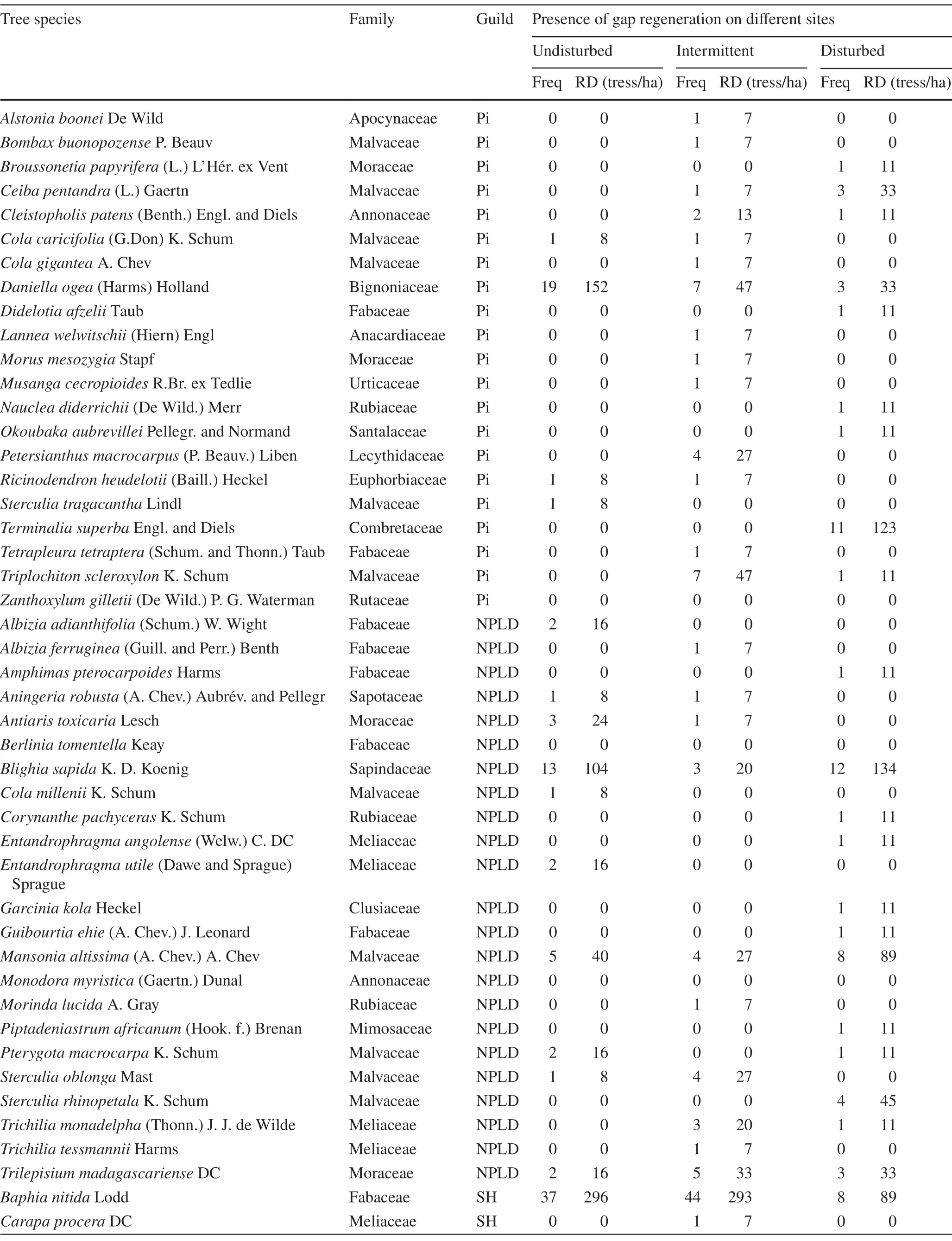
Table 2 Species composition of gap regeneration under different intensities of forest disturbance
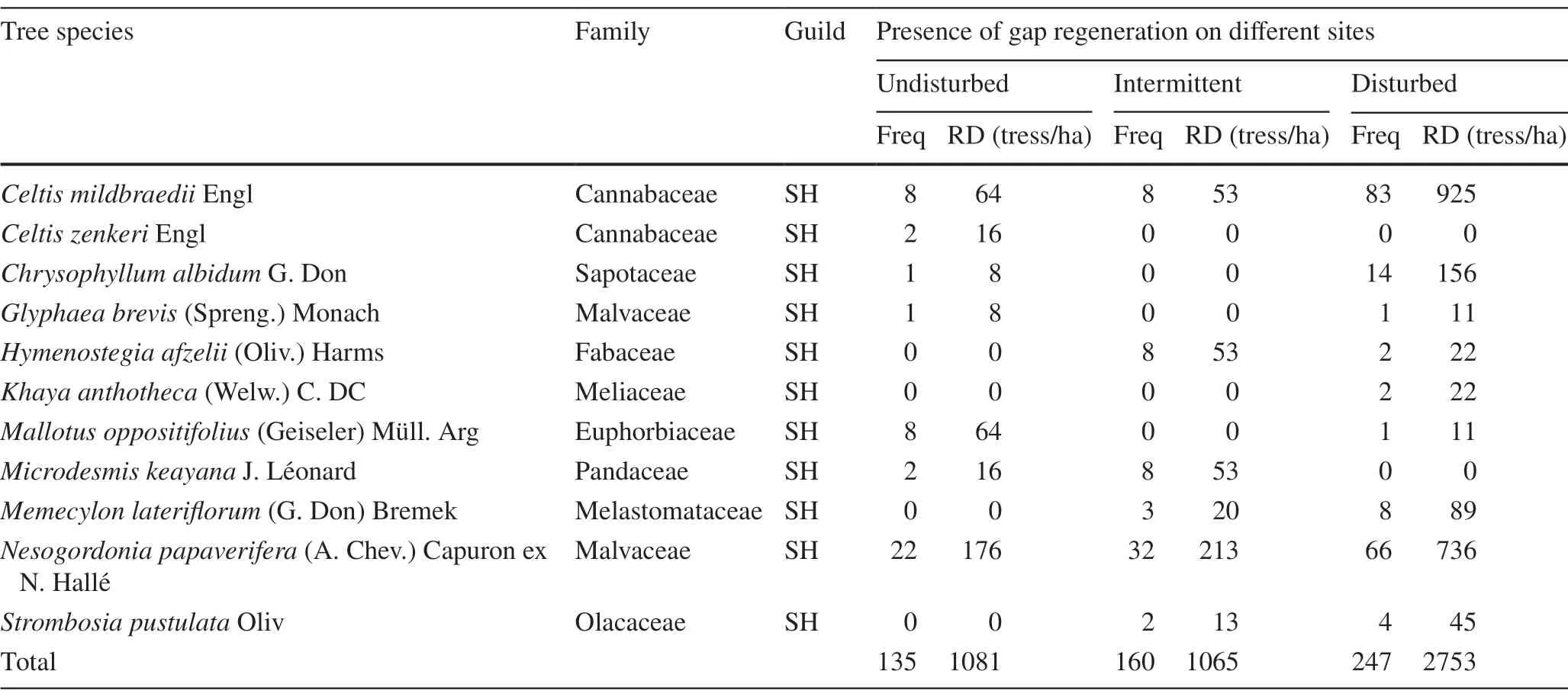
Table 2 (continued)
Estimations of various diversity indices revealed significant differences among the forest sites for Simpson’s,Equitability and Berger-Parker indices atp<0.05 significance level.However,there was no significant difference(p>0.05) for Shannon diversity and Margalef richness indices (Table 3).

Table 3 Multiple comparisons of biodiversity indices on undisturbed,intermittently disturbed,and disturbed sites
Additionally,for the three sites in species similarity tests,all indices were lower than 0.5 (Table 4).This indicates that sites shared less than 50% similar species in gap regeneration composition.
Regeneration density and abundance of species under different shade tolerant categories
Estimated mean regeneration density on the disturbed site(910 ± 103 trees/ha) was significantly higher (p<0.05)than on the undisturbed (361 ± 42 trees/ha) and intermittently disturbed (358 ± 78 trees/ha) sites (Fig.2).In addition,higher proportions of shade tolerant species (disturbed site=77%,intermittently disturbed site=66%,and undisturbed site=60%) compared to non-pioneer,light-demanding species (undisturbed site=24%,intermittently disturbed site=15% and disturbed site=14%) and pioneer species(intermittently disturbed site=19%,undisturbed site=16%,and disturbed site=9%) were observed in the following proportions:undisturbed site (4:2:1),intermittently disturbed site (4:1:1) and disturbed site (10:2:1).Shade tolerant species were the most abundant in gaps on the three sites,recording the highest significant (p<0.05) mean regeneration densities on the undisturbed site,216 ± 25 trees/ha,on the intermittently disturbed site,237 ± 73 trees/ha and on the disturbed site,698 ± 63 trees/ha (Fig.3).However,there was no significant difference between pioneers (59—82 trees/ha)and non-pioneer,light-demanding species (54—130 trees/ha)for average regeneration density on all sites (Fig.3).
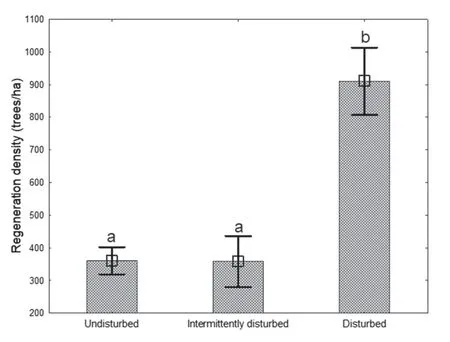
Fig.2 Mean regeneration densities of tree species on three sites;bars with same letters denote homogenous groups statistically at p <0.05;whiskers denote means (n=3) while bars denote standard errors
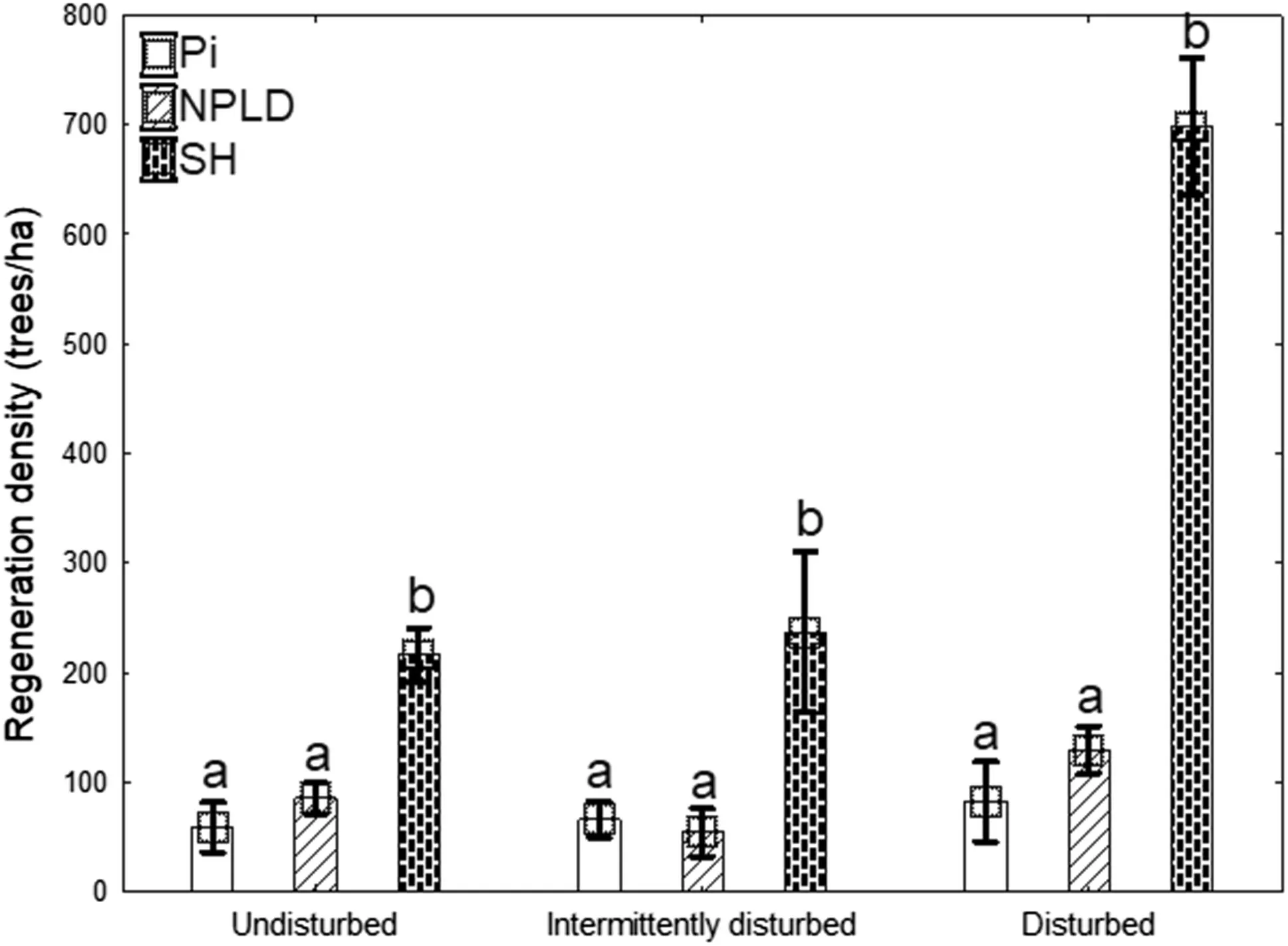
Fig.3 Multiple comparative analysis of gap regeneration:Pi—pioneer,NPLD—non-pioneer,light—demanding and SH—Shade tolerant species on three sites under varying disturbance;bars with same letters denote homogenous groups statistically at p <0.05;whiskers denote means (n=3) while bars denote standard errors of means
Discussion
Effects of disturbance on gap size
The mean gap sizes of the three sites were significantly different from each other.Occurrences of both natural and anthropogenic logging treefalls,resulting in higher number of treefalls incidences,could be explained for the wider mean gap size on the intermittently disturbed site compared to those measured on the undisturbed and disturbed sites.This observation is consistent with the group selection system described in the study by Hammond and Pokorny (2020b) who felled a high number of trees to create large gaps.In addition,the morphological attributes of treefalls (height,dbh and crown characteristics) found on the intermittently disturbed and undisturbed sites explained the observed relatively wider mean gap sizes (>1000 m2).This aligns with the studies of Agyeman et al.(1999) and Herrmann (2011) who also expressed the importance of tree allometry in gap size determination.Multiple treefalls of overly matured trees,i.e.,over the MFD limits,on undisturbed sites resulted in comparatively larger gap size.Rentch et al.(2010) noted how treefalls from multiple standing dead trees (snags),broken trunks,or damaged uprooted mature trees in old-growth forests in West Virginia formed expansive gaps.Conversely,gaps on the disturbed site in this study formed from single treefalls,hence their relatively small size(<900 m2).These gap-forming treefalls were from highvalue commercial species that were mostly below management guideline—MFD limits.Logging,leading to gap creations on the disturbed site was often perpetuated by illegal loggers or chainsaw operators who normally operate at night,making it difficult for forest authorities to curb their activities.This assertion affi rms findings in the assessment of tree species exploitation in Ghana by Adam et al.(2006)and Oduro et al.(2011) who reported that illegal logging operators exploit diverse tree species (over 60 species from 49 genera) with stem diameters well below the national MFD guideline.Similarly,in the Nkrabia Forest Reserve of Ghana,all logging gap sizes (457 m2) were created by illegal chainsaw operators (Herrmann 2011).
This result supports Fischer et al.(2016) who noted that anthropogenic forest disturbances form a prominent role of many tropical forests and perhaps remain the underlying cause of forest gap formation in the tropics.
Effects of disturbance on species composition and biodiversity
By def inition,species composition is the presence of specific species within a distinct geographical location (Forman and Godron 1986).Therefore,the rich species composition encountered in various gaps under forest sites at the Bia Tano Forest Reserve (Table 2) is an evidence-based finding that tropical forests are indispensable floral biodiversity repositories (Slik et al.2015),accounting for 96% of global tree diversity (Rozendaal et al.2019).This study demonstrates the potential of gaps as optimum regeneration sites for numerous species (Muscolo et al.2011;Hammond et al.2020).Further,the degree of composition of pioneer and non-pioneer light-demanding species in this study conf irms views that gaps are favored spaces for light-demanding species (Fredericksen and Pariona 2002;de Carvalho et al.2017;Hammond et al.2020).
According to Krebs (2001),when the estimated SSI(Sorensen’s Similarity Index) value is below 0.5,then the sites share a different species composition but when above 0.5,the species composition of the sites is similar.Our examination of species similarity revealed that all three groups (Table 4) share different natural regeneration composition.In another tropical forest in central Africa,the estimated SSI of comparing primary and secondary forest (44%)(Ifo et al.2016) was higher than that obtained for undisturbed and disturbed sites (42%) and lower than the value for undisturbed and intermittently disturbed sites (48%) in this study.This supports Lawer et al.(2013) observation that gap formation due to anthropogenic activities have overall effects on forest conditions and species composition.Similarly,Denslow (1980) suggested that variations in species composition between communities during successional stages in plant communities are due to the influence of selection on life-history strategies under different disturbance regimes,and our research attests to this.
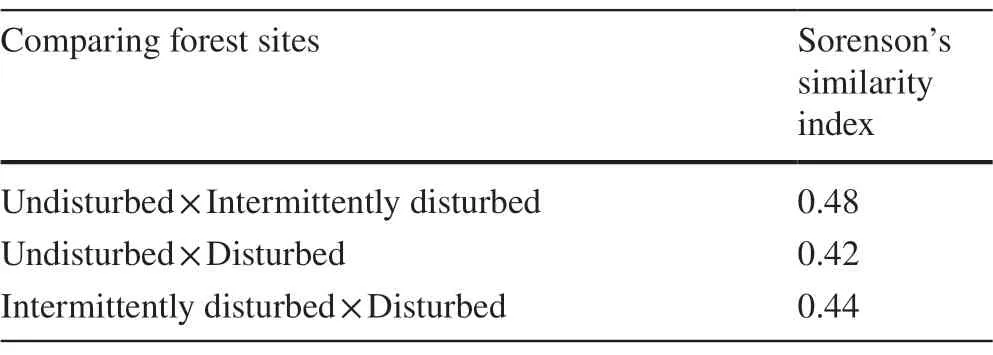
Table 4 Comparison of species composition similarities of gap regeneration among sites under varying disturbances
The results show no significant species diversity differences between undisturbed and intermittently disturbed sites(Table 3),in contrast with the results of Wiafe (2014) who recorded higher diversity on undisturbed areas compared to slightly disturbed areas.At the same time,our results show significant diversity differences between undisturbed and disturbed that are consistent with Wiafe (2014) under similar conditions.The sharing of comparable patterns of species diversity and richness between undisturbed and intermittently disturbed sites could possibly be that forest sites being in the same geographical area,shared similar natural and ecological conditions and thus,ref lected similar assemblages of natural communities (Forman and Godron 1986;Olson et al.2001;Hill and Curran 2003) .However,the differences between undisturbed and intermittently disturbed sites and disturbed sites in species diversity and richness in this study could be due to differences in the intensities of anthropogenic disturbances (Wiafe 2014) found between the former two sites and the disturbed site.Our results conf irm that a higher magnitude of anthropogenic disturbance causes overall diversity to decline (Lawer et al.2013) by eliminating sensitive late-succession species on gap microsites(Bongers et al.2009).In a tropical forest in Brazil soon after logging operations,higher species diversity occurred at the initial stage of gap regeneration at disturbed sites but by the eighth post-logging year,species diversity was not different from species diversity at undisturbed sites (de Carvalho et al.2017).Contrary to our results,Hubbell et al.(1999) and Hill and Curran (2003) noted that spatial and temporal variants of a disturbance regime cannot explain either variations or patterns of species richness following different degrees of disturbances.Furthermore,the disturbed forest site in this study with the highest Berger-Parker index exhibited the resilience and dominance potential ofCeltis mildbraediiandNesogordonia papaveriferain gap regeneration under the disturbed habitat.
Forest disturbance is a vital phenomenon that triggers the establishment of species coexistence within forest ecosystems.
Effects of disturbance on regeneration density
Higher significant regeneration on the disturbed site (Fig.2)was a result of the regeneration dominance of semi-deciduousCeltis mildbraediiandNesogordonia papaveriferaspecies.This corroborates the work of Hawthorne and Gyakari(2006) thatC.mildbraediiandN.papaveriferaare abundant in moist and dry semi-deciduous forests across tropical Africa.By contrast,in other African tropical forests,Eilu and Obua (2005) and Wiafe (2014) observed high natural regeneration on undisturbed sites.
The lower average regeneration density at the undisturbed site is a result of the multilayered,complex canopy structure which served as seed repositories,hence preventing seeds from reaching the forest floor as well as the depth of litter.Over time,advance regeneration was suff ocated by the heavy accumulation of litter.However,at the intermittently disturbed site,low regeneration density was evidence of adverse effects of unregulated anthropogenic disturbances.Eilu and Obua (2005) and Rentch et al.(2010) noted that gap disturbances are often related to tree damage,poor distribution of regenerating species,mechanical damage to regeneration,and an increase seedling mortality.
Effects of disturbance on shade tolerance properties of natural regeneration
The high percentage of shade tolerant species (>60%),as well as the significantly higher regeneration (over 200 seedlings/ha) (Fig.3) on all sites shows the competitive advantage of these species in gap regeneration.The consistent replacement and opportunistic regeneration traits of shade tolerant species in gaps and the rapid colonization but also rapid mortality of pioneer species may explain this.Several authors have reported this for different tropical forests (Fredericksen and Pariona 2002;Peña-Claros et al.2008;Toledo et al.2011;de Carvalho et al.2017;Hammond and Pokorný 2020a).The replacement of pioneer by shade tolerant species in gap environments has been termed as cyclic succession,i.e.,successive forest cycles consisting of abundant proportions of non-pioneer tree species,(Whitmore 1989) while Hammond and Pokorný (2020a) called it an ecological regeneration shift,i.e.,sequential replacement of pioneers by shade tolerant species in gaps.Similarly,in a mixed temperate forest,Hammond et al.(2020) encountered abundant proportions of shade tolerant species in gaps ranging between 764—1291 m2.In contrast to our results,Whitmore (1969) and Bongers et al.(2006) observed decreased numbers and distribution of shade tolerant species in natural regeneration in other disturbance-prone tropical forests.
It is significant that in gap regeneration,pioneer tree species are often unpredictable in composition (Hubbell et al.1999).Therefore,to maintain balanced proportions of natural regeneration of species with different growth attributes,the sustainability of high diversity levels and species quality(Hill and Curran 2003) and diversified structural characteristics of successional forests need to be championed,especially when designing silvicultural systems based on gap dynamics (Schliemann and Bockheim 2011).
Conclusions
This study showed that tree allometry,the growth and size of trees,and the magnitude of disturbances determine gap sizes on undisturbed,intermittently disturbed,and disturbed forest sites.Although the magnitude of forest disturbance was disproportional to gap size,it had,however,a significant impact on species composition,diversity,and richness on the sites.Species diversity on undisturbed and intermittently disturbed sites was significantly higher than on the disturbed site.Dominance of semi-deciduousC.mildbraediiandN.papaveriferasignificantly influenced the low species diversity on the disturbed site.Nevertheless,all three sites shared different species composition.Higher regeneration density on the disturbed sites compared to the undisturbed and intermittently disturbed sites was recorded.Over each site,shade tolerant species were the highest represented,while gap-dependent pioneers were poorly represented.Shade tolerant species were considered to be opportunistic replacers of pioneer species.Pioneer species giving way to shade tolerant species is a natural process,thus make them worst variant in gap regeneration.
In summary,species composition and diversity in tropical forests depend on forest type and conditions,ecological area,[site quality,edaphic conditions],and the intensity and frequency of anthropogenic disturbances,including forest management.
AcknowledgementsWe are grateful to the Goaso Forest Services Division of Ghana for technical and field support during data collection.Finally,we want to express our profound gratitude to Mr.Emmanuel Paul Kane for his immeasurable support.
Open AccessThis article is licensed under a Creative Commons Attribution 4.0 International License,which permits use,sharing,adaptation,distribution and reproduction in any medium or format,as long as you give appropriate credit to the original author(s) and the source,provide a link to the Creative Commons licence,and indicate if changes were made.The images or other third party material in this article are included in the article’s Creative Commons licence,unless indicated otherwise in a credit line to the material.If material is not included in the article’s Creative Commons licence and your intended use is not permitted by statutory regulation or exceeds the permitted use,you will need to obtain permission directly from the copyright holder.To view a copy of this licence,visit http://creat iveco mmons.org/licen ses/by/4.0/.
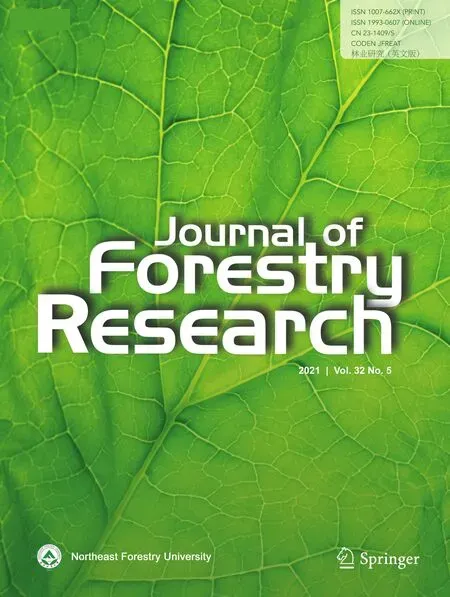 Journal of Forestry Research2021年5期
Journal of Forestry Research2021年5期
- Journal of Forestry Research的其它文章
- Performance and genetic diversity of 23 provenances of northern red oak (Quercus rubra L.) after 25 years of growth in South Korea
- Morphological and genetic differentiation in isolated populations of Mexican beech Fagus grandifolia subsp.mexicana
- Tree species classification using deep learning and RGB optical images obtained by an unmanned aerial vehicle
- Can small-scale altitudinal gradients predict spatial and temporal patterns in tropical forests?
- Shade and sapling size influence restoration of Araucaria angustifolia
- Genetic diversity and differentiation among populations of the pedunculate oak (Quercus robur) at the eastern margin of its range based on a new set of 95 SNP loci
